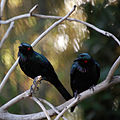| Metallic starling | |
|---|---|
 | |
| At Cairns, Queensland, Australia | |
| Scientific classification | |
| Kingdom: | Animalia |
| Phylum: | Chordata |
| Class: | Aves |
| Order: | Passeriformes |
| Family: | Sturnidae |
| Genus: | Aplonis |
| Species: | A. metallica |
| Binomial name | |
| Aplonis metallica (Temminck, 1824) | |
The metallic starling (Aplonis metallica), also known as the shining starling, is a bird in the starling family native to the Moluccas, New Guinea, Queensland and the Solomon Islands.









